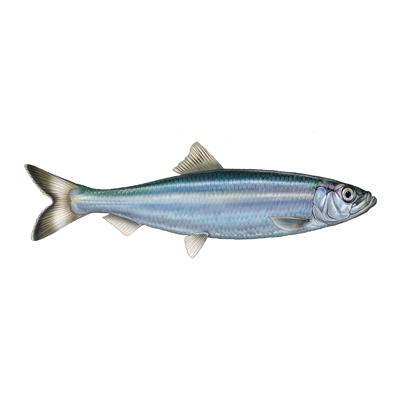

Oily silver fish high in omega 3 oil. Herring can grilled, smoked (kippers) or baked and is very good for you!
Herring is rarely targetted by Cornish boats. The latest scientific data (June 2020) shows that herring stocks in the Celtic sea are currently very low and are being over fished (though this is being carried out by boats from outside Cornwall). Herring landed to Cornwall are caught by gill netters, driftnetters and by ring netting, mainly from the south coast. Fishing methods used have no or little impact on the seabed and are currently managed at an appropriate level. In the Celtic sea the majority of the catch is made by the Irish fishing fleet who are operating under a long term management plan since 2011 and a rebuilding plan has been in place since 2009, however the latest ICES report shows that stocks are very low and this species gets a default rating of 5 due to advice from ICES that there should be a zero catch in 2022. Little is known about stocks in the Western Channel.
41 tonnes of herring were landed to Cornish ports in 2021 with a value of £21.8k (MMO data).
Updated July 2023
Cornish vessels landing to Cornish ports
Drift nets are similar to gill nets but they are not fixed to the seabed and are hung in mid water to create a wall of net aimed to catch mid water fish species.
Learn moreCornish Vessels landing to Cornish ports
Ring nets are encircling nets used to catch midwater fish such as sardine, and anchovy. They are set around a shoal and a drawstring rope on the bottom of the net is pulled so the fish can’t escape. The net is drawn in and then the fish are scooped out of the net with a pan net.
Learn moreCornish waters
Herring are occasionally caught by handliners, but due to the fact that this stock is overfished it has a default rating of 5
Learn moreCornwall Good Seafood Guide rates fish on sustainability using a scale of 1 to 5.
1, 2 and 3 are recommended, Fish to avoid are rated 5.
We use the system devised by the Marine Conservation Society (MCS) so our scores are comparable with the scores produced by MCS for the UK and fisheries from all around the world. For more information on scoring click here.
Herring belongs to the same family of fish (clupeids) as sprat and pilchard. It can grow to greater than 40cm, although size differs between 'races' (distinct breeding stocks). Most herring landed are around 25cm. Herring are sexually mature at between 3-9 years (depending on stock) and populations include both spring and autumn spawners. At least one population in UK waters spawns in any one month of the year. Herring have an important role in the marine ecosystem, as a transformer of plankton at the bottom of the food chain to higher trophic or feeding levels, e.g. for cod, seabirds and marine mammals. It is also considered to have a major impact on other fish stocks as prey and predator and is itself prey for seabirds and marine mammals in the North Sea and other areas. Herring spawning and nursery areas are sensitive and vulnerable to human influences such as sand and gravel extraction.
Herring are mainly caught by drift nets and ring nets in Cornish inshore waters, both methods that have few issues with by catch or discards. This stock is rarely targetted with between 50 and 200 tonnes landed to Cornwall each year (MMO data). They are occasionally caught by handliners.






Cornwall Good Seafood Guide is underpinned by the Marine Conservation Society (MCS) Good Fish Guide. The first UK consumer guide to sustainable seafood. For more information visit www.fishonline.org
Cornwall Good Seafood Guide is here to help us all make sustainable seafood choices. Choices that will help us keep the oceans healthy and Cornish fishers' futures safe. This website is funded by Cornwall Wildlife Trust. If you would like to make a meaningful difference to the health of our oceans, please consider making a donation to the Cornwall Wildlife Trust Ocean Emergency fund. Your donation will help safeguard these remarkable environments, ensuring that they continue to thrive for generations to come. Together, we can be stewards of the seas and champions for a healthier, more sustainable future.